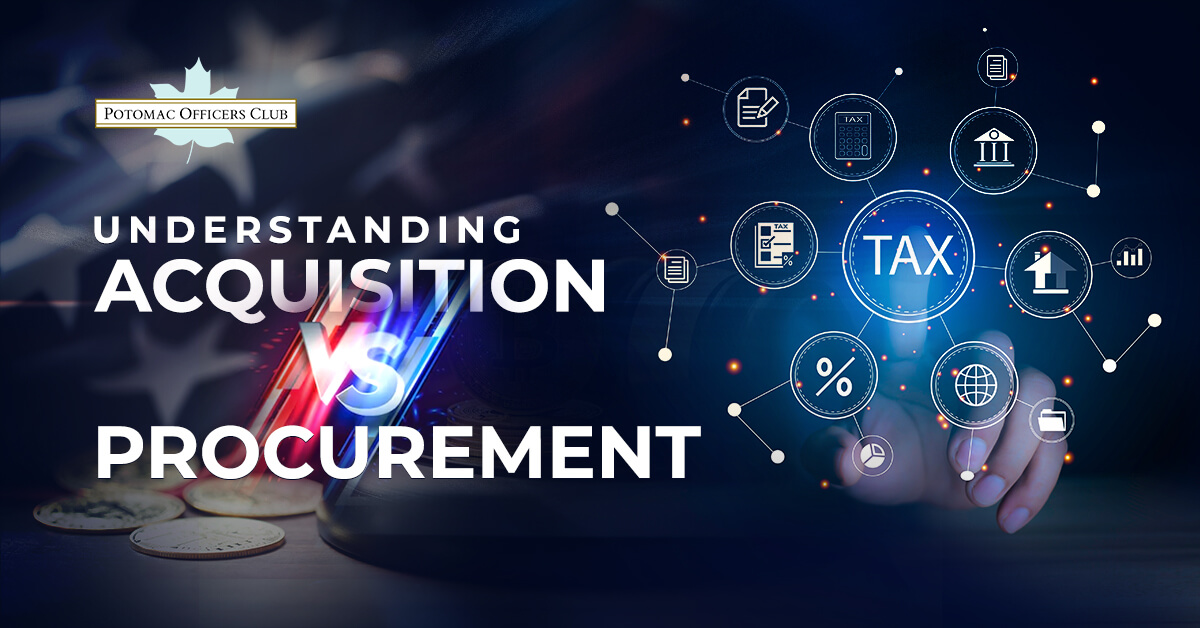
The Difference Between Acquisition and Procurement
In business operations, “procurement” and “acquisition” are often used interchangeably, but they mean two different things.
Sound confusing?
You’re not alone.
If you’ve always been confused when it comes to procurement-related situations, understanding the differences between acquisitions and procurement can help you confidently navigate these discussions.
In a nutshell, “procurement” involves locating, purchasing and obtaining goods, services, or works, while “acquisition” pertains to gaining possession beyond goods and services.
By the end of this read, you will comprehensively understand the divergent paths of procurement and acquisition. So, let’s get started.
Potomac Officers Club events are the best place to find new contract opportunities from the federal government, network with important decision-makers and learn more about the technologies agencies are procuring. Be sure to attend the much-anticipated 2025 Artificial Intelligence Summit on March 20 and check out the full lineup of first-rate GovCon conferences.
Acquisition and Procurement: Key Differences
Here are the key differences between acquisitions and procurement. While there is some overlap, procurement is a smaller part of the larger acquisition process.
| Procurement | Acquisition |
| Obtains goods and services | Acquires or takes over something, e.g., assets of companies |
| Routine purchases of supplies and equipment | Significant purchases, e.g., buying a company or a brand |
| Governed by procurement policies and procedures | Governed by legal and financial regulations |
| Short-term, tactical and cost-oriented | Long-term, strategic and value-oriented |
| Less complex planning is required as it only focuses on purchasing | Requires careful planning to secure resources in all stages of creation and assembly |
| Involves multiple stakeholders, including procurement officers, finance teams and end-users | Involves a smaller number of stakeholders, including senior executives and legal advisors. |
What Is Procurement?

Procurement involves obtaining or purchasing goods or services, typically for business purposes. It involves sourcing, purchasing and supply chain management and ensures that the purchaser receives products, services, or works at the best possible price when quality, quantity, time and location are compared.
Procurement can also refer to a contractual obligation to “procure,” i.e., to “ensure” something is done. When a government agency buys goods or services through this practice, it is called government procurement or public procurement.
Procurement is usually tied to businesses because companies must solicit services or purchase goods on a relatively large scale.
Types of Procurement
Direct Procurement
Direct procurement focuses on getting the right parts, materials, or services directly used to create and produce a company’s end products. This responsibility is typically assigned to product-oriented organizations’ manufacturing or operational teams.
Various goods and services are necessary to develop a company’s product line. For example, a government contractor involved in national security projects may need to procure specialized computer components, software, or services to implement advanced military systems.
Direct procurement is prevalent in the government contracting sector, where specific requirements dictate the acquisition of components for strategic initiatives.
Supplier relationship in direct procurement is crucial as it directly affects the company’s revenue and growth. After all, you don’t want to constantly find new sources of raw materials. The key is to find a reliable supplier who understands your needs and delivers the goods consistently.
Indirect Procurement
Indirect procurement is more common in service-based companies. Businesses often need to source various things to keep their operations running smoothly. We’re discussing categories like contracted services, professional consulting, marketing and promotional activities, and facility maintenance.
These are behind-the-scenes non revenue-generating essentials that help the company function effectively. Nevertheless, this “indirect” spending can make up a significant portion of a company’s expenses.
Other purchasing activities mainly serve the company’s internal and overall efficiency and sustainability. Things like acquiring employee training programs, managing insurance coverage, and procuring safety and services fall under this category.
The goods and services involved in indirect procurement are often consumable and temporary. That’s why it’s still important to establish trust and build relationships with suppliers because it can help buyers compare prices, find the best deals and renew contracts.
Why Is Procurement Important for Businesses?

It creates brand value
Investing in procurement helps you create a fresh and successful brand. While marketing is often the go-to for building brand value, never overlook the role of procurement. Your suppliers are the extensions of your organization. They bring value that can be transformed into something even greater for your customers.
What your suppliers do and create shapes how your customers perceive you. You can boost this value and supercharge your brand by managing supply chain risks effectively.
It avoids legal issues
Procurement saves businesses by keeping them out of legal trouble. It makes sure that businesses follow the law and avoid disputes with customers and suppliers in the long run. Plus, it’s a time and money-saver that streamlines the buying process.
In government procurement, policies protect public money from cronyism and ensure fair practices. They tackle everything from trade policies to anti-money laundering laws.
In business procurement, policies are influenced by the growing demand for corporate social responsibility (CSR). You can think of it as a moral guide for purchasing decisions. For example, a government agency seeking construction services may receive bids from companies with questionable track records.
A robust procurement policy mandates federal agencies to select companies with a strong track record of past performance, ethical practices and environmental sustainability.
Hence, procurement is not solely focused on securing the best deal but also on fairness and adherence to the law.
It ensures the quality of products and services
When businesses purchase items or services, they must ensure that they receive their money’s worth and that the supplier meets their expectations. Here are several ways to assess suppliers:
- Metrics: This includes monitoring certain metrics, such as tracking the number of on-time deliveries, average price and product defects.
- Certification: The industry standard for certification is SO BS/EN ISO 9001:2000, which signifies that the supplier excels in management responsibility, resource management, product realization, measurement, analysis and improvement.
- Capacity: The supplier must have sufficient capacity to handle your company’s requirements. Inquire how they respond to your needs and market and supply fluctuations.
- Cost: Evaluate the cost of the supplier’s product or service and compare it with other options you are considering.
- Service: Assessing service excellence includes response times for issue resolution and consistent engagement for client satisfaction.
- Delivery: Examine how timely and accurately the supplier delivers the product or service. If they can’t deliver goods and materials promptly, it will adversely affect your business operations.
Examples of Procurement
Construction
A commercial construction company involved in building complexes must acquire materials, equipment and services like steel, cement, electricity and landscaping. They participate in the procurement process by negotiating prices, dealing with suppliers, and overseeing the delivery of goods and services to the site.
Renowned companies in this sector include Kiewit and Turner Construction. Kiewit’s procurement and supply chain management experts utilize a vast network of nationwide and local vendors to optimize procurement spending. This enables them to execute complex projects according to strict schedules while keeping costs as low as possible.
Through its subsidiary SourceBlue, Turner Construction has procured materials and equipment for major construction projects for over two decades.
Healthcare
Hospitals must obtain medical equipment, supplies and services such as surgical instruments, pharmaceuticals and medical devices. They collaborate with procurement professionals to identify suitable suppliers, negotiate pricing and terms, and ensure compliance with all relevant laws and regulations.
Medicaid-managed care procurements represent some of the largest state purchasing endeavors, often exceeding billions of dollars annually. States are responsible for the selection process and purchasing specifications, and they manage the procurements according to their own rules, with limited federal oversight until contracts are awarded.
Medicaid and CHIP Payment and Access Commission (MACPAC) comprehensively reviews state practices for selecting managed care plans and evaluates how procurements impact service delivery and the achievement of policy goals.
National Defense
The U.S. Department of Defense procures various military equipment, vehicles and services from various contractors. For instance, Lockheed Martin is awarded contracts for aircraft, General Dynamics for submarines and Sig Sauer for ammunition, which comprise a significant portion of government spending.
Procurement opportunities abound at Potomac Officers Club events. Be sure to explore the full slate of GovCon conferences, which range from DOD-focused to cyber industry-centered, and register for the 2025 AI Summit on March 20.
What Is Acquisition?

An acquisition is a business transaction where one company purchases all or a portion of another company’s stock or assets. When the acquiring firm buys at least 50% of the target company’s stock or assets, it can make decisions regarding the acquired company without approval from its shareholders. Acquisitions are typically carried out through cash payments, stock transfers, or a combination.
Types of Acquisitions
Vertical acquisition
Vertical acquisition occurs when one company in an industry acquires another operating company at a different role in the supply chain, known as planning, production, sourcing, or transportation.
This allows the owner to gain more control over distribution and production, leading to a competitive advantage. Vertical integration involves merging companies serving different functions in the supply chain, enabling the controlling company to oversee the entire or most of the supply chain and eliminate operational inefficiencies.
- General Dynamics acquired Axsys Technologies, which provided high-performance electro-optical infrared camera systems, precision optical components and motion control products, to provide imaging solutions to the military, law enforcement and the civilian world.
- AECOM acquired Shimmick Construction, a construction firm, to expand its operations in the West as it anticipated increased infrastructure activity.
Horizontal acquisition
A horizontal acquisition occurs when a company buys or takes over another company in the same industry or production stage. It aims to increase market share, gain efficiencies, diversify products and create synergies by consolidating competing firms. This strategy, also known as horizontal integration, often seeks to reduce costs by achieving economies of scale.
- Facebook acquired Instagram for $1 billion to dominate in the online social sharing space
Congeneric acquisition
A congeneric merger involves related companies with different products that may share distribution channels and technology for easy integration. It allows the acquiring company to expand its product line or gain market share. After the merger, both companies operate as one, unlike in a conglomerate merger, where they remain separate under the same owner.
- Procter & Gamble acquired Gillette to surpass mass-market retailers like Wal-Mart, making it the largest company for consumer products globally.
Why Is Acquisition Important for Businesses?

It increases market share
When two companies operate in the same market or offer similar products, their combined efforts can increase the market share of the newly merged company. Furthermore, acquisitions can expand product and service diversity, attracting new customers and boosting revenue.
One of the largest transactions is Lockheed Martin’s acquisition of Sikorsky Aircraft, a strategic move into the production of rotary-wing aircraft for both military and commercial clients.
Specifically, the deal broadened Lockheed’s range of military aircraft and granted the company a 65% stake in the U.S. military rotary-wing aircraft sector, including the manufacturing of the Black Hawk helicopter. For this acquisition, Sikorsky Aircraft was rebranded as Sikorsky.
Enhances distribution capacity
Acquisitions can help businesses expand geographically to tap into new or international markets. These can attract new customers and generate more revenue, leading to overall growth and success. It’s also an opportunity to connect with a larger group of potential customers interested in the company’s offerings.
For instance, BAE Systems acquired U.S. Ball Aerospace for $5.5 billion to beef up its presence in the government space market and strengthen its relationship with NASA. Also, back in 2008, BAE Systems‘ acquisition of Tenix Defence in Australia made it the biggest arms producer in the country.
It reduces competition
Acquiring a competitor can lessen competition in highly saturated markets with more supply than demand.
For instance, Zeplug operates in the fast-growing market of third-party EV charging operators for homeowners’ associations in France. It acquired its competitor, Bornes Solutions, to eliminate competition and strengthen its position in the industry.
However, not all acquisitions are permitted. Section 7 of the Clayton Act of the U.S. antitrust law prohibits mergers and acquisitions that could significantly lessen competition or create a monopoly.
To illustrate, consider the case of Lockheed Martin, a prominent aerospace and defense company. When Lockheed Martin attempted to acquire Aerojet, antitrust regulators intervened and sued to block the acquisition.
The regulators argued that allowing Lockheed Martin, which was Aerojet’s biggest customer, to take over the company would severely disadvantage Lockheed Martin’s competitors. As a result, the deal was canceled.
For technological gains
When a company acquires another company, it can access advanced technology that the acquired company has successfully developed and implemented. This is often more cost-effective than independently developing new technology from scratch.
Pfizer acquired Seagen, a company that has made significant progress in developing a therapy known as antibody-drug conjugates. This therapy utilizes anticancer agents to target and attack tumor cells.
Pfizer already has a drug, Ibrance, that treats this condition. Leveraging the potential synergy between Seagen’s therapy and Pfizer’s existing drug could establish a comprehensive portfolio of breast cancer treatments.

Category: Articles





